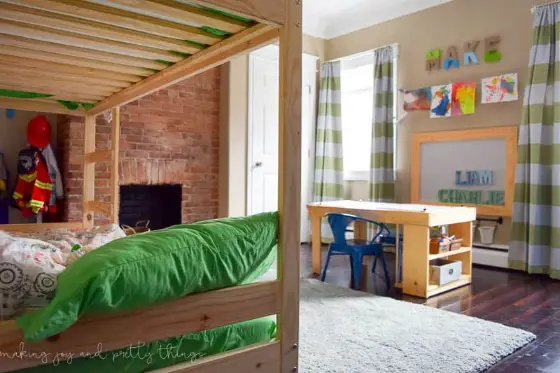Decorating a shared bedroom for kids can be a challenging yet rewarding task. Whether it’s for siblings sharing a room or frequent sleepovers with friends, creating a space that accommodates multiple personalities and interests requires careful planning and creativity.
From maximizing space to fostering individuality, here are various tips and ideas to help you design a shared bedroom that’s both functional and fun.
Maximizing Space with Bunk Beds

Bunk beds are a classic solution for shared bedrooms, offering a practical way to save space while adding an element of adventure. Opt for sturdy, well-built bunk beds with safety rails to ensure a secure sleeping environment.
Consider selecting a comfortable and supportive bunk bed mattress to ensure a restful night’s sleep for both children. Additionally, consider bunk beds with built-in storage drawers or shelves to maximize vertical space and keep clutter at bay. To add a personalized touch, let each child choose their bedding and decorative pillows to reflect their unique style.
Creating Separate Zones
Divide the shared bedroom into distinct zones to give each child their own space while promoting a sense of privacy. Utilize area rugs or floor mats to delineate individual territories within the room. For example, one area could be designated for sleeping and relaxation, while another serves as a study or play area. Arrange furniture strategically to create separate nooks without sacrificing overall functionality.
Personalized Storage Solutions
Effective storage is essential for keeping a shared bedroom organized and clutter-free. Invest in versatile storage solutions such as cubbies, bookshelves, and storage bins to accommodate toys, books, and clothing.
Encourage children to personalize their storage areas with labels, decorative bins, or DIY projects. By giving each child ownership over their storage space, you empower them to take responsibility for tidying up and maintaining order in the room.
Customized Decor
Incorporate elements of personalization into the bedroom decor to celebrate each child’s interests and passions. Hang framed artwork or posters that showcase their favorite hobbies, animals, or characters. Allow them to choose wall decals or removable wallpaper to add color and personality to the room without committing to permanent designs.
Consider creating a gallery wall where each child can display their own photos, drawings, and achievements, fostering a sense of pride and individuality.
Flexible Furniture Arrangement
Choose furniture that can adapt to the changing needs and preferences of growing children. Opt for modular or multi-functional pieces that can be easily rearranged to accommodate different activities or layouts. For example, a desk with adjustable height settings can serve as a study area for one child and a craft table for another.
Similarly, consider seating options such as bean bags or floor cushions that can be moved around to create cozy reading nooks or impromptu play areas.
Neutral Base with Pops of Color
When selecting a color scheme for the shared bedroom, opt for a neutral base palette that provides a versatile backdrop for various accents and accessories. Soft, soothing hues such as light gray, beige, or pastels create a calming atmosphere conducive to relaxation and sleep.
Introduce pops of color through bedding, curtains, rugs, and decorative accents to inject personality and vibrancy into the room. Encourage children to express their individuality by selecting their favorite colors or patterns for their bedding and decor elements.
Incorporating Shared Interests
Identify shared interests or hobbies that both children enjoy and incorporate them into the bedroom decor. Whether it’s a love for sports, animals, outer space, or fantasy adventures, use themed decor elements to create a cohesive and engaging environment. Consider adding a themed wall mural, bedding set, or decorative accessories that reflect their mutual passions. By celebrating their shared interests, you foster a sense of camaraderie and cooperation between siblings or roommates.
Encouraging Collaboration
Involve children in the decorating process to empower them to make choices and express their creativity. Encourage open communication and collaboration when selecting furniture, decor items, and layout options. Take their input into consideration and incorporate their ideas and preferences wherever possible. By involving children in the decision-making process, you not only create a space that reflects their personalities but also instill a sense of ownership and pride in their shared bedroom.
Shared Reading Corner

Foster a love for reading by creating a cozy shared reading corner within the bedroom. Arrange a comfortable seating area with bean bags, floor cushions, or a small sofa, surrounded by bookshelves stocked with age-appropriate books. Encourage children to take turns selecting books to read aloud to each other or enjoy quiet reading time together before bedtime.
Themed Play Spaces
Transform a corner of the bedroom into a themed play space where children can immerse themselves in imaginative play. Whether it’s a miniature kitchen for pretend cooking adventures, a dress-up corner for theatrical performances, or a construction zone for building and creating, tailor the play area to suit the interests and preferences of the children. Incorporate themed decor, costumes, and props to enhance the immersive experience.
DIY Art Gallery
Showcase children’s artwork and creative projects by setting up a DIY art gallery wall in the shared bedroom. Hang a clothesline or wire across one section of the room and use clothespins or clips to display their masterpieces. Rotate the artwork regularly to keep the display fresh and allow each child to feel proud of their creations. This not only adds a personal touch to the decor but also boosts children’s self-esteem and artistic expression.
Collaborative Mural Painting
Spark creativity and teamwork by inviting children to collaborate on a mural painting project for the bedroom walls. Provide washable, non-toxic paints and designate a section of the wall where children can unleash their artistic talents. Encourage them to brainstorm ideas, sketch out designs, and work together to bring their vision to life. This collaborative art project not only adds a unique focal point to the room but also strengthens bonds between siblings or roommates.
Conclusion
Decorating a shared bedroom for kids requires thoughtful planning, creativity, and a focus on maximizing space and fostering individuality. By incorporating bunk beds, creating separate zones, implementing personalized storage solutions, and customizing decor, you can design a functional and inviting space that accommodates the unique needs and preferences of each child.
With flexibility, collaboration, and a touch of imagination, you can create a shared bedroom that inspires creativity, encourages cooperation, and nurtures lifelong memories.






